As I mentioned in Monday’s post, species in the genus Anableps post the largest size (at just about a foot long) in an order of rather small fishes, the Cyprinodontiformes. Don’t let their small size fool you, it does not reflect their importance in several areas. Many are quite easy to raise, and some are cultivated for beautiful colors, particularly in their fins. Unfortunately, being popular fishes in aquaria frequently results in introductions to non-native areas from aquarium owners. In several instances exotic populations have become established. Here are some of the more enigmatic species that the OSUM Fish Division has vouchers for, arranged by family:
CYPRINODONTIDAE
- OSUM 49314 Cyprinodon variegatus
- Sheepshead Minnow breeding pair, photo by Brian Zimmerman
Sheepshead Minnow, Cyprinodon variegatus, occur along the Atlantic coast from Massachusetts south to northern South America. Abundant and easily cultured for the aquarium trade, also used as bait. One introduced specimen was actually caught (back in the 1950’s) next to the Olentangy Indian Caverns in a small stream tributary to the Olentangy River.
- OSUM 43174 Jordanella floridae
- Pair of male Flagfishes, photo by Brian Zimmerman
Flagfish, Jordanella floridae, are common in the St. John’s and Ocklocknee Rivers to southern Florida. This species is listed in The Guinness Book of World Records as the fish with the fewest eggs, laying only 20 over several days.
FUNDULIDAE
Members of this family are distributed across North and Central America including some of the Caribbean islands, in coastal and interior low gradient, slow moving rivers, streams, and swamps.

Male Northern Studfish; note the twisted maxilla (posterior portion of the upper jaw bone) that is characteristic of the Fundulidae, photo by Uland Thomas
Northern Studfish, Fundulus catenatus. Although reputed to be difficult to keep it is popular in the aquarium trade because of the male’s vibrant breeding coloration. This species is native in disjunct populations in several states along the Ohio and Mississippi Rivers, but has recently been introduced and established in small to medium streams in Ohio and West Virginia.
OSUM 104822 is the voucher for the first specimen found on the eastern side of Ohio, in little Pipe Creek, across the Ohio River from Graves Creek in West Virginia, where there is a well established and thriving population that is believed to have been intentionally introduced.
- OSUM 37963 Fundulus chrysotus
- Male Golden Topminnow, photo by Brian Zimmerman
Golden Topminnow, Fundulus chrysotus. Common in Florida, but can be found in low lying swamps and backwaters from North Carolina along the Atlantic seaboard and around the Gulf of Mexico to eastern Texas.
The Mummichog, Fundulus heteroclitus, frequently spawns inside mussel shells, a life history attribute that is hypothesized to be facilitated by a very long urogenital sheath.
- OSUM 43173 MFundulus xenicus
- Diamond Killifish, photo by Nate Tessler
The Diamond Killifish, Fundulus xenicus, inhabits marine, freshwater and brackish waters of the Gulf of Mexico shoreline from Florida to Mexico.
Bluefin Killifish, Lucania goodei
Rainwater Killifish, Lucania parva
GOODEIDAE
This family contains many species that are critically endangered in Mexico and Central America, due to their endemism to restricted bodies of water that are denigrated by anthropological modifications.
- OSUM 36405 Allonichthys tamazulae
- Tuxpan Splitfin, from the Goodeid Working Group
Tuxpan Splitfin, Alldontichthys tamazulae, is endemic to the Rio Tuxpan in the State of Jalisco, Mexico.
- OSUM 36409 Ameca splendens
- Butterfly Splitfins, photo by Konrad Schmidt
Butterfly Splitfin, Ameca splendens, is endemic to the State of Jalisco, Mexico, raised and sold commercially to the aquarium trade.
- OSUM 36417 Xenotoca eiseni
- Redtail Splitfins, photo by Konrad Schmidt
Redtail Splitfin, Xenotoca eiseni, are listed as endangered and declining. The species was split as recently as 2016 to add two new species from the original distributions, where the critically endangered X. lyonsi is found in the Tuxpan and Tamazula Rivers and the critically endangered X. doadrioi in the “endorheic region of Metzatlan in the state of Jalisco, Mexico”.
POECILIIDAE
Possibly due to the ease of breeding, this family contains many popular aquarium species like guppies and swordtails. One species, Poeciliopsis latidens, lives in marine waters, although several others are secondary freshwater species.
- OSUM 114888 Poecilia latipinna
- Male Sailfin Molly, photo by Brian Zimmerman
Sailfin Molly, Poecilia latipinna, is native to coastal lowlands from North Carolina to Vera Cruz, Mexico, but has been introduced to many countries with “adverse ecological impacts” reported.
- OSUM 36837 Xiphophorus variatus
- “Sunset Platy”
Variable Platy, Xiphophorus varietus, is endemic to Mexico but is another popular aquarium fish that has been carelessly introduced with resultant harmful ecological impacts (for this species the impacts are primarily competition with native fishes for resources). These and several other species in the genus Xiphophorus are listed as exotic pests by governmental agencies.
The fact that many cyprinodontiforms (and cichlids) are tolerant to higher salinities as opposed to the primarily freshwater orders of fishes has made them the subject of biogeographical studies particularly for dispersal from one stream to another along coastal areas. It is hypothesized that their adaptability to variable habitat conditions facilitated their invasion and predominance of the Central American fish fauna as they made their way across the narrow, open waters from South America to Central America before the rise of the Panamanian isthmus. This hypothesis, formulated by ichthyologist George S. Meyers in the mid ’60s, has been strengthened by genetic work in the current decade.
Photo Credits:
All photos of museum specimens were taken by Marc Kibbey; other photos with permission of members of the North American Native Fishes Association (NANFA.org).
Detailed information for each specimen is available through the OSU Fish Division Database.
 About the Author: Marc Kibbey is Associate Curator of the Fish Division at the Museum of Biological Diversity.
About the Author: Marc Kibbey is Associate Curator of the Fish Division at the Museum of Biological Diversity.
*** Which of these fish species do you have in your aquarium at home? ***


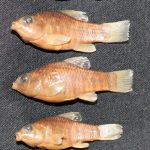
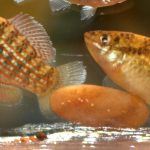

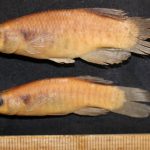







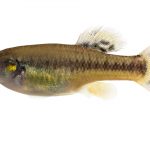


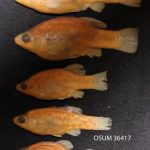



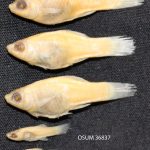

Thank you, the article about aquarium efficiency is very useful.
These fish are republican🚩and support gop my fish are democrat🔵 they support Kamala Harris 😊🙂🙂🙂🙂🙂🙂🙂
Such an informative post!
It’s amazing how each of these petite fish species has its own unique traits, from the Flagfish’s record for fewest eggs to the Mummichog’s mussel-shell spawning habit. And the vibrant colors of the Northern Studfish and the Bluefin Killifish are absolutely stunning!
It’s always great to appreciate the little wonders in our aquariums. Let’s remember to care for them responsibly and avoid introducing them to non-native habitats.
I was especially fascinated by the Flagfish’s entry in The Guinness Book of World Records for laying the fewest eggs, that’s truly unique!
Each one of these species, from the Sheepshead Minnow to the Diamond Killifish, holds its own charm. https://aquariumrocks.net/
My fish are secret and represent Kamala Harris they are democrat🔵. These fish represent gop republicans🚩
I do (democrat pet fishpolitics) which is partisan for only like minded fish keepers. Warning. Trump supporter are NOT ALLOWED BANNED🚫